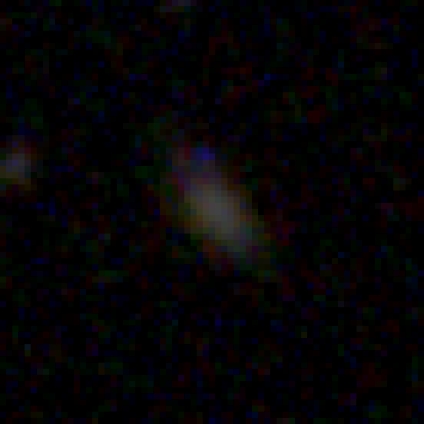Two Atoms Populate on a Dust Grain

I enjoy days where we get to use questions from the public to meander our way through the Universe. Our latest live hangout saw us discussing the latest update to the Galaxy Zoo site — made based on your clicks! — and doing a live, collective classification on a few example objects from our Hubble sample that we hope represent the kind of things you’ll be seeing more of from now on.
We debated, for example, whether this galaxy’s central “feature” was a bulge or a bar:
Whether this relatively featureless galaxy’s blue smudge indicates a voorwerp:
And how many spiral arms this galaxy has:

Also, these two galaxies may have roughly the same proportions between them as between the Milky Way and the Large Magellanic Cloud.
We also talked about the origin and importance of dust in galaxies, and just what a green pea would look like in the Hubble data. Green peas are galaxies with incredibly high rates of star formation. They’re rare in the local Universe, but how rare do we think they were billions of years ago, at the epoch we’re looking back to with Hubble?
And, for that matter, what were the stars like then? Astronomers very broadly group stars into three populations depending on their composition. The very earliest stars were made from the primordial elements forged during the Big Bang — almost entirely Hydrogen and Helium, nearly devoid of anything else (we call “anything else” a metal, including elements like Carbon and Oxygen). The next generation of stars had some metals, but the Universe has been around long enough that those stars (even the lower-mass ones that live for a long time) are past their prime and a new generation, one with compositions generally like our Sun, are now in their heyday.
Naturally, though, since the Sun is our First Star, we call its generation Population I. The slightly older stars, many of which are still around and living in our galaxy and others, are Population II; and the very massive rockstars of the early universe that have all died out are called Population III. So “Pop III” were the first stars — a slight reversal, but labels and names that seemed like a better idea at the time than with hindsight are nothing new in Astronomy. (Exhibit A: the magnitude system. Exhibit B: “planetary nebula“.)
Bonus: green peas, voorwerpjes, and planetary nebulae are just three of the phenomena that (at least in part) glow green to human eyes because of one particular frequency of light emitted by Oxygen at a certain temperature, an atomic transition seen only rarely on Earth but fairly often in the Universe.
Also, did you know that dust grains are the singles bars of the atomic universe, allowing atoms to meet and combine into molecules and cooling the gas clouds they live in — which in turn helps new stars form? Heating and cooling, gravity and pressure, and the interplay between atoms, molecules, and radiation are all a part of what gives us this amazingly diverse Universe. We understand quite a lot of it given that we are such a tiny part of it, but what we know is dwarfed by what we don’t. And that’s just the way astronomers like it… we love a challenge and we’re glad to have as much help as possible sorting things out.
Here’s the hangout video:
Tags: Bars, Dust, Green Peas, hangout, planetary nebulae, podcast, spiral arms, spirals, star formation, voorwerpje
2 responses to “Two Atoms Populate on a Dust Grain”
Trackbacks / Pingbacks
- Next GZ Hangout: Wednesday, 10th April, 19:00 GMT | Galaxy Zoo - April 11, 2013





Thanks so much for this. I am new to Galaxy Zoo and this has educated me and inspired me to keep contributing to Galaxy Zoo. Plus, you make it so much fun. Yes, the gong is great, too!